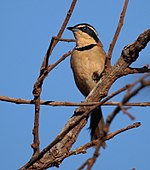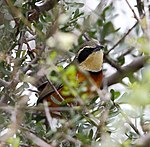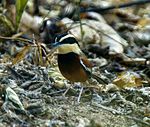Superregnum: Eukaryota
Regnum: Animalia
Subregnum: Eumetazoa
Cladus: Bilateria
Cladus: Nephrozoa
Superphylum: Deuterostomia
Phylum: Chordata
Cladus: Craniata
Subphylum: Vertebrata
Infraphylum: Gnathostomata
Superclassis: Tetrapoda
Cladus: Reptiliomorpha
Cladus: Amniota
Classis: Reptilia
Cladus: Eureptilia
Cladus: Romeriida
Subclassis: Diapsida
Cladus: Sauria
Infraclassis: Archosauromorpha
Cladus: Crurotarsi
Divisio: Archosauria
Subsectio: Ornithodira
Subtaxon: Dinosauromorpha
Cladus: Dinosauria
Ordo: Saurischia
Cladus: Theropoda
Cladus: Neotheropoda
Infraclassis: Aves
Ordo: Passeriformes
Subordo: Tyranni
Infraordo: Tyrannides
Parvordo: Furnariida
Superfamilia: Formicaroidea
Familia: Melanopareiidae
Genus: Melanopareia
Species: M. bitorquata – M. elegans - M. maranonica - M. maximiliani - M. torquata
Name
Melanopareia Reichenbach, 1853
Typus: Synallaxis maximiliani d’Orbigny, 1835 = Melanopareia maximiliani
Synonyms
Rhoporchilus Ridgway, 1909 Proc.Biol.Soc.Wash. 22 p. 69
References
Primary references
Reichenbach, H.G.L. 1853. Handbuch der speciellen Ornithologie. Icones ad synopsin avium no.10. Scansoriae i–ii, 145–218. Dresden und Leipzig. Expedition Vollständigsten Naturgeschichte. DOI: 10.5962/bhl.title.102901 BHL Reference page. First availability p. 146 BHL Original description p. 164 BHL
Additional references
Ericson, P.G.P., S. L. Olson; M. Irestedt; H. Alvarenga & J. Fjeldså. 2010. Circumscription of a monophyletic family for the tapaculos (Aves: Rhinocryptidae): Psiloramphus in and Melanopareia out. Journal of Ornithology 151 (2): 337–345. Full article (PDF) DOI: 10.1007/s10336-009-0460-9 Reference page.
Lopes, L.E. & Gonzaga, L.P. 2016. Melanopareia bitorquata (d'Orbigny & Lafresnaye, 1837) is a distinct species: an appraisal of morphological variation in the Collared Crescentchest Melanopareia torquata (zu Wied-Neuwied, 1831) (Aves: Melanopareiidae). Zootaxa 4193(1): 138–150. DOI: 10.11646/zootaxa.4193.1.6. Full text (PDF) Reference page.
Vernacular names
English: Crescentchests
español: Pecholunas
suomi: Sepeltapakulot
The crescentchests are a genus, Melanopareia, of birds from South America. The genus has long been placed with the tapaculos in the family Rhinocryptidae. Their placement there has been questioned and in 2007 the genus was placed in its own family, Melanopareiidae, by the South American Classification Committee.[1] Subsequently, the family was accepted by the International Ornithological Congress Bird List and the Clements Checklist.[2][3] The family Melanopareiidae was formally erected in 2009.[4]
The crescentchests range in length from 14 to 16 cm (5.5–6.3 in), in weight from 16 to 23 g (0.56–0.81 oz) and have relatively long tails compared to the tapaculos. The plumage is striking with a distinctive band across the chest that gives the group their name.[5]
The crescentchests are birds of arid scrub. They generally forage on the ground, but their diet has not yet been recorded. Two species, the collared crescentchest and olive-crowned crescentchest, are widely distributed across central and southern Brazil, Bolivia, Paraguay and northern Argentina. The double-collared crescentchest, which was recently split from the collared crescentchest, is found in eastern Bolivia, whilst the other two species, the elegant crescentchest and Marañón crescentchest, have a more restricted distribution in Peru and Ecuador.[5]
Little is known about the behaviour of the crescentchests. The only species about which anything is known about the breeding behaviour is the olive-crowned crescentchest. That species is a seasonal breeder. The nest of that species is a 15 cm high cup made of vegetable fibres and palm fronds, hidden in grasses or low shrubs close to the ground. The clutch size is two to three eggs, the eggs are white with blotches or black spots.[5]
No species of crescentchest is considered by the IUCN to be threatened by human activities, but the Marañón crescentchest is listed as near threatened. Although the species is apparently tolerant of some disturbance it has a tiny global range and is uncommon even within that range.[5]
Melanopareia maximiliani d'Orbigny, 1847
Species
The genus contains the following five species:[6]
| Image | Common Name | Species | Distribution |
|---|---|---|---|
 |
Collared crescentchest | Melanopareia torquata | northeastern Bolivia and northern Paraguay. |
| Double-collared crescentchest | Melanopareia bitorquata | eastern Bolivia | |
 |
Olive-crowned crescentchest | Melanopareia maximiliani | Argentina, Bolivia and Paraguay. |
| Marañón crescentchest | Melanopareia maranonica | southern Ecuador and northern Peru. | |
 Ecuador S4E9216 (16644372590).jpg" decoding="async" srcset="//upload.wikimedia.org/wikipedia/commons/thumb/6/6f/Elegant_Crescent-chest_-_South_Ecuador_S4E9216_%2816644372590%29.jpg/225px-Elegant_Crescent-chest_-_South_Ecuador_S4E9216_%2816644372590%29.jpg 1.5x, //upload.wikimedia.org/wikipedia/commons/thumb/6/6f/Elegant_Crescent-chest_-_South_Ecuador_S4E9216_%2816644372590%29.jpg/300px-Elegant_Crescent-chest_-_South_Ecuador_S4E9216_%2816644372590%29.jpg 2x" data-file-width="766" data-file-height="646" height="127" width="150" /> Ecuador S4E9216 (16644372590).jpg" decoding="async" srcset="//upload.wikimedia.org/wikipedia/commons/thumb/6/6f/Elegant_Crescent-chest_-_South_Ecuador_S4E9216_%2816644372590%29.jpg/225px-Elegant_Crescent-chest_-_South_Ecuador_S4E9216_%2816644372590%29.jpg 1.5x, //upload.wikimedia.org/wikipedia/commons/thumb/6/6f/Elegant_Crescent-chest_-_South_Ecuador_S4E9216_%2816644372590%29.jpg/300px-Elegant_Crescent-chest_-_South_Ecuador_S4E9216_%2816644372590%29.jpg 2x" data-file-width="766" data-file-height="646" height="127" width="150" /> |
Elegant crescentchest | Melanopareia elegans | Ecuador and Peru. |
References
Cadena, C (2006) Proposal #239) to South American Classification Committee: Remove Melanopareia from the Rhinocryptidae and create family Melanopareiidae Archived 2008-05-16 at the Wayback Machine. Downloaded 9 October 2008
IOC (2009). "IOC World Bird List". Archived from the original on 24 March 2010. Retrieved 29 December 2009.
Clements Checklist team (2009). "Updates & Corrections – Dec 2009". The Clements Checklist of Birds of the World. Archived from the original on 27 January 2010. Retrieved 29 December 2009.
Ericson, Per; Olson, Storrs L.; Irestedt, Martin; Alvarenga, Herculano; Fjeldså, Jon (2010). "Circumscription of a monophyletic family for the tapaculos (Aves: Rhinocryptidae): Psiloramphus in and Melanopareia out" (PDF). Journal of Ornithology. 151 (2): 337–345. doi:10.1007/s10336-009-0460-9.
Krabbe, N.K., and T.S. Schulenberg. (2003). Family Rhinocryptidae (Tapaculos), pp. 748 –788 in del Hoyo, J., A. Elliott & D.A. Christie, (eds) Handbook of the Birds of the World Vol. 8.Broadbills to Tapaculos. Lynx Edicions, Barcelona. ISBN 84-87334-50-4
Gill, Frank; Donsker, David, eds. (2017). "Antthrushes, antpittas, gnateaters, tapaculos, crescentchests". World Bird List Version 8.1. International Ornithologists' Union. Retrieved 4 February 2018.
Retrieved from "http://en.wikipedia.org/"
All text is available under the terms of the GNU Free Documentation License

